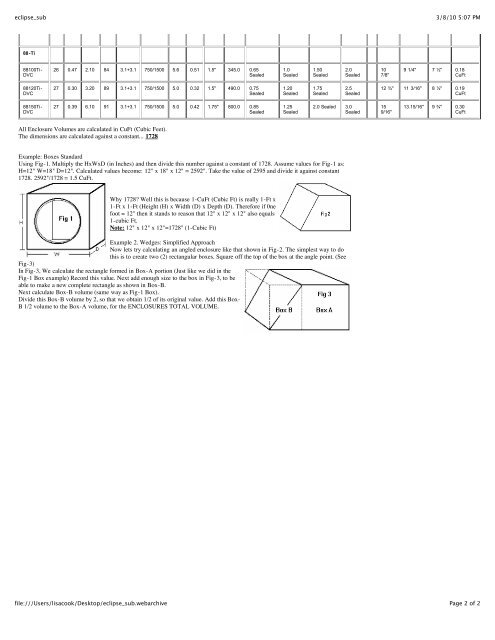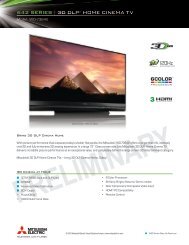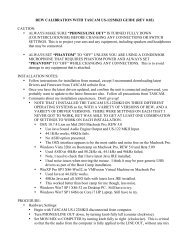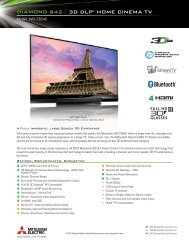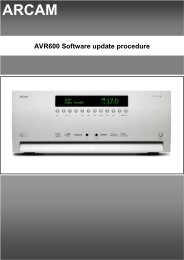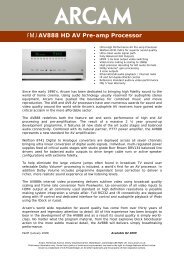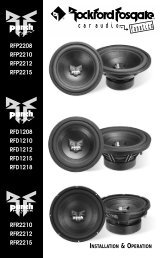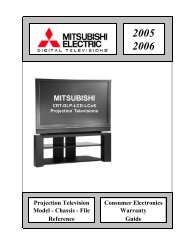Model Subwoofer Loudspeaker Thiele / Small Parameters Recommended ...
Model Subwoofer Loudspeaker Thiele / Small Parameters Recommended ...
Model Subwoofer Loudspeaker Thiele / Small Parameters Recommended ...
- No tags were found...
Create successful ePaper yourself
Turn your PDF publications into a flip-book with our unique Google optimized e-Paper software.
eclipse_sub<br />
3/8/10 5:07 PM<br />
88-Ti<br />
88100Ti-<br />
DVC<br />
26 0.47 2.10 84 3.1+3.1 750/1500 5.6 0.51 1.5" 345.0 0.65<br />
Sealed<br />
1.0<br />
Sealed<br />
1.50<br />
Sealed<br />
2.0<br />
10<br />
Sealed 7/8"<br />
9 1/4" 7 ½" 0.18<br />
CuFt<br />
88120Ti-<br />
DVC<br />
27 0.30 3.20 89 3.1+3.1 750/1500 5.0 0.32 1.5" 490.0 0.75<br />
Sealed<br />
1.20<br />
Sealed<br />
1.75<br />
Sealed<br />
2.5<br />
12 ¾" 11 3/16" 8 ½" 0.19<br />
Sealed CuFt<br />
88150Ti-<br />
DVC<br />
27 0.39 6.10 91 3.1+3.1 750/1500 5.0 0.42 1.75" 800.0 0.85<br />
Sealed<br />
1.25<br />
Sealed<br />
2.0 Sealed 3.0<br />
Sealed<br />
15<br />
9/16"<br />
13.15/16" 9 ¾" 0.30<br />
CuFt<br />
All Enclosure Volumes are calculated in CuFt (Cubic Feet).<br />
The dimensions are calculated against a constant... 1728<br />
Example: Boxes Standard<br />
Using Fig-1. Multiply the HxWxD (in Inches) and then divide this number against a constant of 1728. Assume values for Fig-1 as:<br />
H=12" W=18" D=12". Calculated values become: 12" x 18" x 12" = 2592". Take the value of 2595 and divide it against constant<br />
1728. 2592"/1728 = 1.5 CuFt.<br />
Why 1728? Well this is because 1-CuFt (Cubic Ft) is really 1-Ft x<br />
1-Ft x 1-Ft (Height (H) x Width (D) x Depth (D). Therefore if 0ne<br />
foot = 12" then it stands to reason that 12" x 12" x 12" also equals<br />
1-cubic Ft.<br />
Note: 12" x 12" x 12"=1728" (1-Cubic Ft)<br />
Example 2. Wedges: Simplified Approach<br />
Now lets try calculating an angled enclosure like that shown in Fig-2. The simplest way to do<br />
this is to create two (2) rectangular boxes. Square off the top of the box at the angle point. (See<br />
Fig-3)<br />
In Fig-3, We calculate the rectangle formed in Box-A portion (Just like we did in the<br />
Fig-1 Box example) Record this value. Next add enough size to the box in Fig-3, to be<br />
able to make a new complete rectangle as shown in Box-B.<br />
Next calculate Box-B volume (same way as Fig-1 Box).<br />
Divide this Box-B volume by 2, so that we obtain 1/2 of its original value. Add this Box-<br />
B 1/2 volume to the Box-A volume, for the ENCLOSURES TOTAL VOLUME.<br />
file:///Users/lisacook/Desktop/eclipse_sub.webarchive<br />
Page 2 of 2


